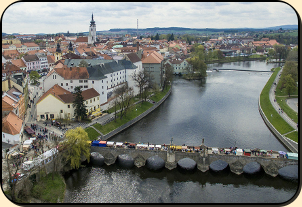 Pisek is located in the Southern Bohemian Region about 90 minutes from the capital city of Prague. The historic center is an urban conservation area. At the heart of the city is a large square, divided into two approximately equal parts. The western part includes the castle, while the eastern part formerly served as a marketplace. Remains of city fortifications including the famous Putim Gate are still preserved.
Pisek is located in the Southern Bohemian Region about 90 minutes from the capital city of Prague. The historic center is an urban conservation area. At the heart of the city is a large square, divided into two approximately equal parts. The western part includes the castle, while the eastern part formerly served as a marketplace. Remains of city fortifications including the famous Putim Gate are still preserved.
What to visit:
The Gothic castle was founded together with the town in 1254. The early Gothic stone bridge from the 13th century is one of the oldest preserved bridges in Europe, and the second oldest such structure in Bohemia – even older than Prague’s Charles Bridge. Its construction was ingenious: the entire bridge was built on dry land, and only then was the river diverted to flow underneath it. The bridge was a very important connection on the way called the „Gold Route“. Replicas of Baroque sculptures are located on the bridge.
The major landmark of the city is the Church of the Nativity of Virgin Mary at the highest point of the historic center. You can also visit the Baroque Marian column in the eastern square or the recent installation, the „Path of Painful Stones“ – a testament to the modern human condition.
Panning for Gold in the Otava River:
The placename „písek“ means „sand“, and probably refers to the river shallows in which valuable metals were to be found. The town’s original Celtic inhabitants used gold to make jewelry as well as the first coins to be used in the region. Later, settlers came to the area to pan for gold. But by the 14th century, almost all the gold in the River Otava had been ‚panned out‘, so prospectors had to resort to mining techniques.
Several gold mines appeared near the town. At the end of 1966, during building work on a new sewage plant, workers discovered an ancient wooden construction and many fragments of circular mill stones. They had found what is thought to be the oldest medieval gold ore mill in the world. The millstone was driven by a waterwheel, and the ground ore was poured into a wooden sluice covered with fur. The water washed away the ground rock and the heavier fragments of gold were caught in the fur. All they had to do then was to wash the fur in a vat and carefully remove the gold.
This story might encourage you to jump into the water to hunt for your fortune. Sadly we don’t allow you to travel wet in our cars!